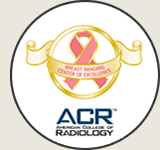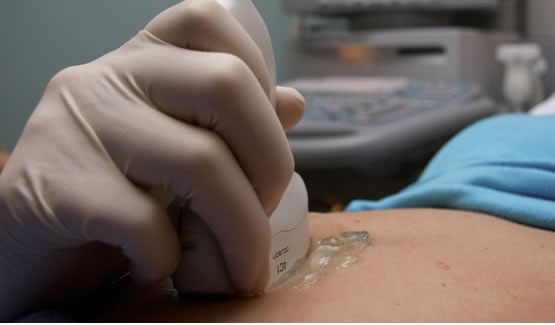 ULTRASOUND ULTRASOUND
Accredited by the American College of Radiology
Ultrasound uses high frequency sound waves to visualize soft tissue organs and vascular structures. It is a painless non invasive way to evaluate a number of internal organs.
Types of exams:
Ultrasound
An OB Ultrasound uses high frequency sound waves to visualize an embryo or fetus of pregnant women. Ultrasound can evaluate a normal pregnancy and determine fetal development and delivery due dates. The ultrasound department has the ability to offer 4-D ultrasound images of your baby and we are certified by The Nuchal Translucency Quality Review Program.
Pelvic, Abdominal, Gallbladder, Kidney, Bladder, Pancreas and Scrotum Ultrasound
Ultrasound of these areas is a painless imaging process that can provide important information. The ultrasound technologist will use a "probe" (transducer) that emits and detects sound waves, offering the ability to visualize internal organs and vessels.
Thyroid Ultrasound
This ultrasound allows the evaluation of the soft tissue structures of the neck such as the thyroid.
Abdominal Aortic Aneurysm Screening
An ultrasound of the abdominal area is performed to evaluate the patient for possible abdominal aortic aneurysm.
Venous/Carotid Ultrasound
Doppler sonography is a specialized imaging process to view vascular function. It allows the radiologist to observe blood flowing through a specific vein or artery. It's an excellent way to identify blood clots in the legs, aortic aneurysm or plaque build up in the carotid artery.
Sonohysterogram
The radiologist will use a "probe" (transducer) to better visualize the endometrium (lining of the uterus). A small catheter is inserted through the cervix and the probe is inserted in the vagina to allow the radiologist to take images. The procedure takes approximately 20-30 minutes.
Thoracentesis
The radiologist uses ultrasound to guide them to an area of fluid collection. The fluid is then drained from the area into a vacuum container.
Paracentesis
The radiologist uses ultrasound to guide them to an area of fluid collection. The fluid is then drained from the area into a vacuum container.
BREAST ULTRASOUND
Breast Ultrasound is often performed as a supplement to mammography. High frequency sound waves are used to make high resolution images of the breast. The radiologist will evaluate these images.
ULTRASOUND GUIDED BREAST BIOPSY
The ultrasound technologist will locate the abnormal area of tissue. The breast is cleansed and anesthetized to minimize pain. A small incision will be made to allow the biopsy needle to pass through the skin. The radiologist will use a special biopsy needed with vacuum assistance to take several tissue samples. A small stainless steel tissue marker will be placed at the biopsy site. Light pressure will be held and a band-aid applied to the incision. A mammogram will be done after the biopsy to confirm accurate tissue-marker placement. The patient will be given post biopsy instructions and asked to return in 3-4 days.
BREAST ASPIRATION
Using ultrasound guidance your breast will be cleansed and anesthetized to minimize pain. A small needle will be advanced to the abnormal area in the breast to remove fluid. Sometimes the fluid will be sent to the lab for evaluation. Occasionally a mammogram will be done following the aspiration to reevaluate the area.
Vero Radiology Women's Imaging Center is fully accredited
by the American College of Radiology.
ULTRASOUND EXAM PREP
- OB/GYN (Pelvic) and bladder only exams: Drink 32 oz/ water one hour prior to exam, water must be completely consumed one hour prior to exam, Do Not Urinate prior to exam. Patients younger than 16 years old please contact our office for specific instructions. Patients greater than 24 weeks pregnant do not have to drink the water.
- For GB/ABD/Aorta/Kidney - no food, drink or medication 6-8 hours prior to exam.
- For Kidney only (renal) - No Prep required.
BIOPSY AND ASPIRATION EXAM PREP:
- Discontinue aspirin 7 days prior to exam
- Discontinue Vitamin E, Plavix and other anticoagulants 5 days prior to exam
- Discontinue blood thinners (Coumadin) 4 days prior to exam.
- PT, PTT and INR will need to be drawn 24 hours prior to the exam for patients taking blood thinners
- Discontinue Gingko Biloba 2-3 days prior to exam
- Please contact your physician prior to discontinuing any medications
|
| 

